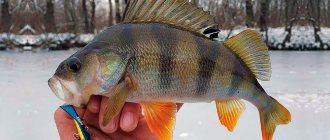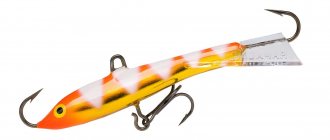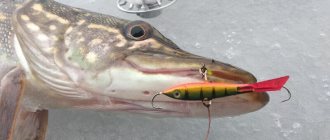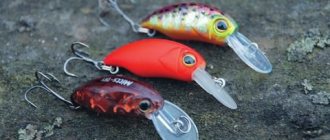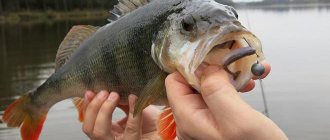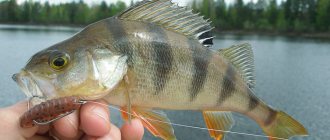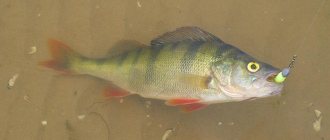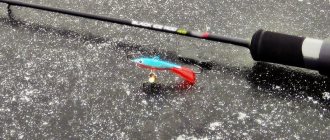Content
- Catching perch in winter on a balance beam - tactics, tackle and bait
- Catching perch in winter. Where to look for fish?
- Catching perch balancers
- Fishing technique
- Should I use a leash?
- Video: Master class on catching perch on a balance beam in winter
- How do you catch perch in winter?
In this article, we tried to collect detailed information regarding the tactics of searching for a striped predator. We recommend the best lures and talk about the technique for submitting them correctly. We share valuable advice from experts.
Where to look for perch in the wilderness
On large bodies of water, it is not necessary to look for striper whales in holes or on snags. Much more often it can be found on areas of ice that are open to snow. Weak diffused light penetrating deep through the ice attracts small and large perch, and drilled holes become additional sources of oxygen.
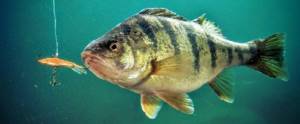
In the middle of winter, it is better to start fishing for large perch with number 7 balancers. Such a large bait is too big for an average bass, but allows you to collect it from a greater distance. In other words, our large balancer is a scout, and if it at least bites on it, but is not caught, then we need to reduce the size of the balancer.
The optimal perch balancer is considered to be a model with a length of 40-50 mm.
It is better to start fishing from old holes so as not to make unnecessary noise, plus, these holes can be fed, and there is more oxygen there, which adds to the chances of catching a striped robber. If the old holes do not bring bites, move away 50 meters and try drilling there.
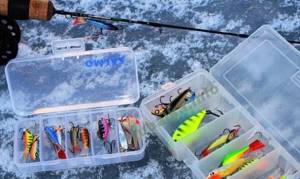
Catching perch in winter on a balance beam - tactics, tackle and bait
Fishermen usually divide perch into 2 main subspecies:
- Small, “sports”, grassy. It develops very slowly and usually does not grow more than 70-100g. Forms large flocks. It feeds on small invertebrates, worms, and bloodworms.
- The deep, humpback, and okovalok are a real predator. Grows in our region for 1.5 kg. Forms not such extensive flocks. The main food is fish fry. This is what we will aim to catch on the balance beam!
Perch fishing is a very dynamic activity because... perch is a schooling and lively fish. If you manage to stumble upon a cluster of fish, then you can completely unwind! The fact is that this striped robber has a very strongly developed food competition reflex, in other words, his greed knows no bounds. He is ready to attack the bait just so that his brother from the pack does not get it. This is what experienced fishermen use.
Catching perch with balance beams is a fun and interesting way of fishing. It is believed that the best time for fishing with these baits is, first of all, the first ice, when the perch is most active. There is an opinion that during the dead winter period, when the striped fish does not have a good appetite, it is better to stir it up with smaller baits: jigs, little devils, “pussies”, etc. A separate detailed article has been written about catching perch with a jig.
According to the last ice, when the fish is preparing for spawning, full of caviar and milk, ichthyologists have the opinion that perch, during this period, has much less desire to attack large baits. But on the first ice you can get ahead of the daring, active perch 100%. But, this is just a theory!
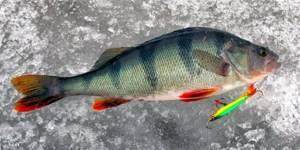
Top best balancers for perch
In order not to wander for a long time in the search, you can use the presented list of the most effective balancers that have proven themselves in practice.
Rapala Jigging Rap

It is used under various reservoir conditions. The length is 3 cm, which makes this balancer a good choice for catching small perch in areas with low current and depth not exceeding 2 meters. Suitable for both smooth and sharp play. If the prey does not show much interest, the pause between retrieves should be increased to 10 seconds. Average cost – 300 rub.
Lucky John Pliant
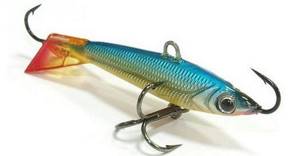
Used in areas with a depth of no more than 3 meters. Shows good results in attracting active and passive fish. Suitable for experimenting with different wiring options. May provoke a bite at the moment of jerking. Price – 250 rub.
Lucky John Mebary

The second balancer from the manufacturer Lucky John. It differs from the previous version in two features:
- In the tail part there is not a single hook, but a tee. Although fishermen advise removing it in order to increase the number of bites and reduce the risk of getting caught on snags.
- On the back there is a fin with three holes for attaching fishing line. Changing the connection location changes the game of the bait.
The price is around 300 rubles.
Aqua Proglot
When looking for catchy balancers for perch in the winter, you should pay attention to this model, since it is recommended for novice anglers. Thanks to its unique design, the bait smooths out the mistakes of a beginner when performing wiring. The weighted front part provides a quick vertical descent, and after tensioning the line it takes a horizontal position. The movements of the tail create vibrations that attract predators.

The cost is low, about 100 rubles. When purchasing, you should carefully inspect them; you may come across low-quality specimens.
Nils Master Baby Shad

Balancer designed for deep water and large perch. Reacts well to wiring without deviating to the side. Active play provokes the predator to instantly bite without hesitation. Price – 150 rub.
Aqua Hopper

Winter fishing for perch with this balancer can be carried out in areas with a depth of up to 4 m. It has an attractive effect even on inactive fish. During the pause, the bait continues to swing on the line. Well suited for use by inexperienced fishermen. Due to the cost of 100 rubles, you don’t mind losing the balancer when hooked.
Spider Pro 106

Good for play that involves twitching and stretching. If you lower it to the very bottom, the balancer will imitate a fish that is feeding. During use, it is better to avoid sudden movements, otherwise the bait may deviate from the hole. Price – 100 rub.
Catching perch in winter. Where to look for fish?
At the beginning of winter, it is better to look for fish in relatively shallow water, in snags, near the remains of last year’s vegetation. You need to drill holes over a large area, in a checkerboard pattern every 5-7 meters. There is no point in staying on one hole for more than 10 minutes. The main thing is to find the fish and get the first bite! They start the search with small baits, and after the flock has revealed its location, they increase the size in order to catch the real trophy - the largest humpback whale from the flock.
Despite the apparent simplicity of fishing with a balance beam, there are quite a lot of nuances and small secrets. Sometimes the perch has to be “winded up” and rocked. The method is aimed at creating competition in a school of fish. Even a not-hungry perch begins to attack the bait if it sees that its comrades are trying to snatch something from under their noses.
To do this, they select the balancer by size, color and, most importantly, change the game. From sharp tossing in different water levels, pauses of different durations, to short shaking and hovering - “mormyshing”. If the plan works out, then the running “conveyor” will bring a large number of perches.
During the deep winter period, the predator moderates its ardor and becomes more passive. It is becoming increasingly difficult to provoke him to bite. Only on the most favorable days can you count on a good bite. At this time, it moves to deeper sections of the river: river bends, holes with a snagged bottom, boulders, etc. Places where it is comfortable to be protected from the current, in well-oxygenated water. In reservoirs you need to look for perch at large differences in depth, near navels, dumps near islands.
Closer to spring, schools of perch move to the shallows, where the water is more quickly saturated with oxygen from melt water. At this time of year it can be caught in 30 cm depth. Watching how the striped ones try to get ahead and steal your balancer from under each other’s noses!
There is no secret that the basic principles in any winter fishing are to move around a lot, drill, search, experiment more often with baits and methods of placing them.
Rating of the 10 most catchy perch balancers
In this section of the article, we will consider the rating of balancers for perch, which have long been tested by fishing practice and the prospect of application for this small predator. Purchasing the presented models to add to your arsenal will help cover most of the fishing conditions that arise, getting the result expected from the trophy.
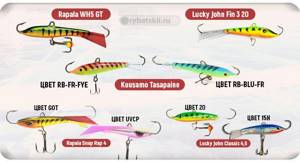
The best models with flowers
- The leader is the model from the Finnish Rapala WH5 in GT color. This imitation of nine grams and 5 centimeters with a tee equipped with a reflective droplet, which acts as an attack point, almost never leaves the angler without a catch.
- Lucky John Fin 3 in color according to the manufacturer's classification at number 20, takes second place. This is one of the smallest tools for medium and small perch, which is the main object of hunting during the freeze-up period.
- Third position goes to the Japanese Kuusamo Tasapaino in the rb-fr-fye and rb-blu-fr colors. We recommend equipping your arsenal with sizes of 50, 60 and 70 mm, allowing you to hunt even large perches.
- It would be a good idea to add Rapala Snap Rap 4 to the collection in GOT and UVCP colors. Experienced fans of ice fishing for perch appreciate these models for the originality and originality of the game.
- The top five is rounded out by another representative from Lucky John Classic 4.5 in colors 15H and 20. The calm and sweeping game attracts passive perch to the hole during periods of deep winter.
- The creative model Lucky John Pro Series Mebaru 37 in colors 201 and 107 is used when perch activity is low. The design of the simulator will allow, by changing the attachment point, to produce a game with a different range.
- Number seven is Rapala Jigging Rap 5 in BYR, BSR colors. The model is endowed with the qualities of a stable and active game, excited even by short pulls with the tip of the fishing rod, attracting a passive predator under the hole.
- Eighth we put the Sprut Hijaro 50 tool, painted in types HP-UV, 50 WB. The unusual structure of the body with shallow wave unevenness of the surface, in addition to the trajectories of movements themselves, can produce vibrations that additionally encourage the perch to attack.
- In the ranking of the best balancers for perch, ninth place was taken by another representative from Lucky John Classic 3 in color variations 19 and 13H. The model is mainly used for fishing deep-water areas on rivers with moderate currents, where croakers are targeted for fishing.
- The deep-sea balancer Lucky John Baltic 4, offered to the buyer in color 201, 13H, closes the list. The manufacturer's innovation in the form of applying corrugations to the body of the bait made it possible to obtain fishing advantages over similar types of bait from other brands of passive perch.

Catching perch balancers
For catching perch, balancers with a length of 3 to 7 cm are often used. For rivers and currents, choose heavier models; for lakes and the sea, you can get by with more elegant and lighter options. The most common colors are acidic and natural. Both of them should be in every angler’s arsenal. If you have teased the fish and it is active, then by and large, it makes no difference what color your bait is. Perhaps this plays a role when you need to seduce capricious fish. Then the angler changes the size, color and game of the balancer, selecting the key.
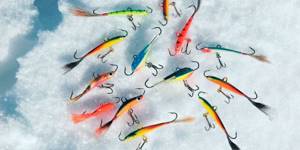
If the tee from the factory is not equipped with a bright droplet or red insulation, then it is recommended to do it yourself. It is believed that this provokes the fish and creates an attack point, focusing the fish's attention on the treble.
When biting is active, many fishermen bite off the front or rear hook of the bait, thereby, when fishing, the balancer less often clings to the edge of the ice, preventing annoying slips.
Top 5 manufacturers that have proven themselves in our water area:
- Rapala
- Lucky John
- Strike Pro
- Nils Master
- Merkuri
In this forum thread, experienced fishermen compare different brands of balancers. Before you run to the store to buy, read the opinion of the masters.
Fishing technique
2 years ago we wrote an excellent article in which we not only talked about choosing a balancer, but also described in detail the fishing technique. Therefore, we will not dwell on this point in detail. This article also provides practical advice from experienced professionals from our city. Be sure to check it out before you hit the ice!
To clearly master the basic techniques of working with bait, we recommend paying attention to the video from the famous Shcherbakov brothers.
The most important thing is to remember that it is not the magic balancer that catches, but the fisherman’s arms, legs and head!
But what specific balancers should still be in the arsenal of every striped trophy hunter is discussed here.
Should I use a leash?
There is a lot of debate on the topic - should you use a leash when you hunt for perch? In our opinion, if you are catching perch in a river snag, you should use a small thin leash, because In these characteristic places, in addition to perch, pike are often bitten. It seems to us inappropriate to leave the working balancer in her mouth. The presence of a leash does not have a significant effect on the bite of an active perch. As a last resort, to “sway” a finicky predator, you can remove the leash, and after the flock has become interested in the bait, put it back and continue fishing.

It doesn’t make much sense to put a leash on the OVH. Since we have little pike in the sea, its bites are rare. The main predator is pike perch and perch!
But here everyone chooses for themselves - both with their wallet and their own experience.

